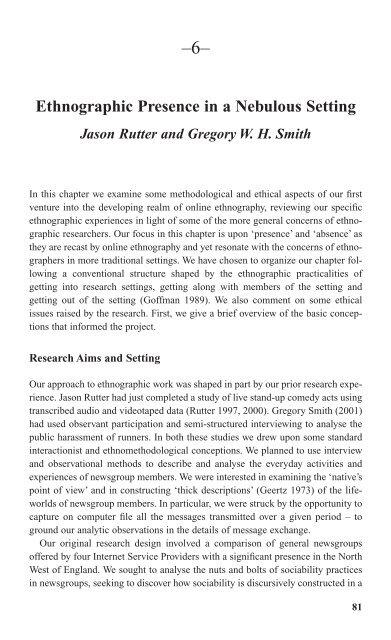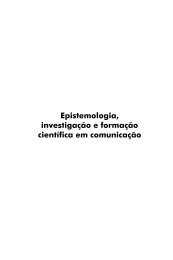Virtual Methods
Virtual Methods
Virtual Methods
You also want an ePaper? Increase the reach of your titles
YUMPU automatically turns print PDFs into web optimized ePapers that Google loves.
–6–<br />
Ethnographic Presence in a Nebulous Setting<br />
Jason Rutter and Gregory W. H. Smith<br />
In this chapter we examine some methodological and ethical aspects of our first<br />
venture into the developing realm of online ethnography, reviewing our specific<br />
ethnographic experiences in light of some of the more general concerns of ethnographic<br />
researchers. Our focus in this chapter is upon ‘presence’ and ‘absence’ as<br />
they are recast by online ethnography and yet resonate with the concerns of ethnographers<br />
in more traditional settings. We have chosen to organize our chapter following<br />
a conventional structure shaped by the ethnographic practicalities of<br />
getting into research settings, getting along with members of the setting and<br />
getting out of the setting (Goffman 1989). We also comment on some ethical<br />
issues raised by the research. First, we give a brief overview of the basic conceptions<br />
that informed the project.<br />
Research Aims and Setting<br />
Our approach to ethnographic work was shaped in part by our prior research experience.<br />
Jason Rutter had just completed a study of live stand-up comedy acts using<br />
transcribed audio and videotaped data (Rutter 1997, 2000). Gregory Smith (2001)<br />
had used observant participation and semi-structured interviewing to analyse the<br />
public harassment of runners. In both these studies we drew upon some standard<br />
interactionist and ethnomethodological conceptions. We planned to use interview<br />
and observational methods to describe and analyse the everyday activities and<br />
experiences of newsgroup members. We were interested in examining the ‘native’s<br />
point of view’ and in constructing ‘thick descriptions’ (Geertz 1973) of the lifeworlds<br />
of newsgroup members. In particular, we were struck by the opportunity to<br />
capture on computer file all the messages transmitted over a given period – to<br />
ground our analytic observations in the details of message exchange.<br />
Our original research design involved a comparison of general newsgroups<br />
offered by four Internet Service Providers with a significant presence in the North<br />
West of England. We sought to analyse the nuts and bolts of sociability practices<br />
in newsgroups, seeking to discover how sociability is discursively constructed in a<br />
81



